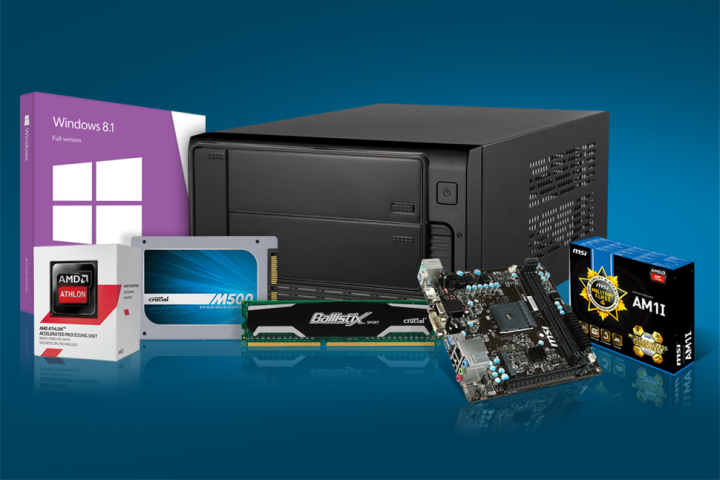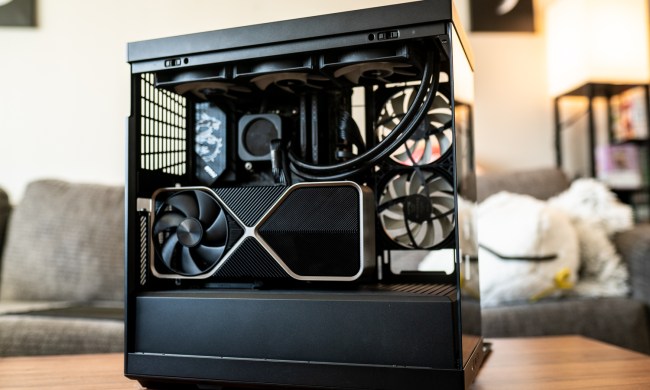
Thanks to AMD’s new AM1 platform, and the plummeting price of solid-state drives, the amount of cash (or credit) you’ll need to put together a reasonably speedy low-cost desktop is now lower than it has ever been before.
The amount of cash you’ll need to put together a reasonably speedy low-cost desktop is now lower than it has ever been before.
To help you build your own budget PC, I’m sharing my parts picks. But if you want to save even more money, be sure to check out our PC parts picking tips story, as well as our guide to scrounging useable parts from an older PC.
The latter story may be essential to this build, as we couldn’t quite fit an optical drive into our budget, which you might need to install your operating system. Though you can install Windows from a flash drive, you’ll of course need a second PC to set that all up. Think about asking a friend with their own PC to help out with that, as an alternative.
Also, before we get into the components for the build, I chose Newegg.com pricing for all the parts. While some of the parts could be found for a bit less elsewhere, Newegg had all the parts I was looking for.
Paying multiple sites for shipping charges on a system build this low-priced generally negated any savings I could find. Still, you should always shop around. Without further delay, here are the parts we chose, and why.
AMD Athlon 5350 ($65)
This is AMD’s highest-end AM1 CPU, a quad-core processor clocked at 2GHz. It’s no powerhouse compared to Intel’s Core CPUs (which cost much, much more), but as I found when I tested it, the 5350 is plenty capable of handling most common PC tasks, including even some light Photoshop or video editing projects.
If you do these kinds of tasks often, you’ll probably want to splurge on something more powerful, like a Core i3 or Core i5-based system. However, the Athlon 5350 gets the job done without feeling underpowered. It also may be a bit cheaper by the time you read this, as the 5350’s MSRP is actually $55.

The Athlon chip also has Radeon HD 8400 integrated graphics. But if you opt for this system, expect to stick to mostly casual games or old titles. The chip isn’t up to the task of handling today’s demanding AAA game titles—even at low settings.
If you don’t ever run Photoshop, edit or transcode video, or do other time-intensive, CPU-taxing tasks, you could get by with one of the lesser AMD AM1 processors. AMD currently offers four chip options for the AM1 platform. However, unless you really don’t do more than use the Web and comb through Facebook, I wouldn’t recommend stepping much below the 1.6GHz Athlon 5150, which costs $50.
MSI AM1I ($36)
MSI’s compact (Mini ITX) motherboard is priced only a couple dollars higher than the lowest-priced AM1 motherboards that are currently available, but it packs nearly all of the hardware features found in more expensive options, like Asus’ similarly named AM1I-A.
The MSI board sports two RAM slots, four USB ports (two of which are 3.0), and a PCIe x16 slot, in case you want to drop in a graphics card at some point. Note, though, that a limitation of the AM1 platform dictates that the slot runs at 4x, rather than full 16x. So if you really want to put together a reasonably powerful gaming system, you should step up to AMD’s slightly pricier FM2 platform, or Intel’s Z87 or new Z97 motherboards.

The standout feature of the MSI AM1I is that it sports a Mini PCIe connector, which lets you add an internal Wi-Fi/Bluetooth chip.
In order to keep costs down, all the AM1 boards available as of this writing lack Wi-Fi. You’ll have to connect to the Internet via Ethernet, or spend a bit more on an internal card. Alternatively, you can get an external USB adapter. With this board, you can add an internal adapter either now, or later on for about $20-$30.
Crucial Ballistix Sport 4GB ($38)
RAM is fairly expensive at the moment, so unless your budget has quite a bit of wiggle room, you’ll have to stick to 4GB. Really, though, 4GB should be fine for anything you’re likely to be doing with a PC in this price range. Just be sure to keep an eye on your browser tabs. So long as you don’t keep more than a few open at a time, memory shouldn’t be a major issue. Plus, you can always add more later if the price comes down.
Crucial M500 120GB ($72)
We chose a solid-state drive for two reasons. You can get a decent 120GB drive for around $70 these days (or even less if you happen to catch one on sale). And, as I pointed out in a recent storage story, a solid-state drive does more to make a system “feel” fast during everyday use than a faster CPU or more RAM will.
If you need more storage space, you can pick up an SSD with twice the storage for around $100, or a Seagate Hybrid drive (which pairs a small SSD cache with a traditional hard drive) with 500GB of storage for $75.
You could also pick up a 1TB traditional hard drive for about $70, but we really wouldn’t recommend that, unless you’re going to use it as a secondary drive. SSDs are really just a better choice for almost everyone, considering their current prices.
Rosewill RS-MI-01 ($40)
If your budget is tight (as ours is for this build), it’s hard to argue with a $40 case that also includes a power supply. This Rosewill cage is also particularly cheap, considering it’s a compact Mini ITX box; tiny cases tend to be a bit pricier than larger mid-towers. Since the motherboard we’re using is tiny, we like the idea of building a system that’s both compact, and inexpensive as well.

Ideally, we’d advise against opting for a low-cost case with a built-in power supply, but there really was no other way to get under the $350 mark while still delivering a decent set of components. At least if you order the Rosewill case from Newegg, you should have an easy way to get a replacement or a refund if the PSU turns out to be defective.
For what it’s worth, this case has a four-star rating with well over 100 reviews.
Microsoft Windows 8.1 ($100)
I know, lots of people don’t like Windows 8. Feel free to substitute it Windows 7 if you like, which is the same price. Linux is also an option if you know what you’re doing on that front, and want to save $100.
I’ve been using Windows 8 since the fall of 2012 on my main productivity desktop, and I actually like it. With recent updates, you can boot right to the desktop, and with a simple tweak, the Start Screen can show your desktop apps. Therefore, I never have to see Live Tiles. or deal with any apps that are built for touch.

Windows 8 has also always been very stable and speedy for me, and I rely on the way it integrates with OneDrive for (mostly) seamless cloud-based storage. But again, pick what you like.
Have a bit more to spend? Here’s what we’d add
As of this writing, the parts for this system total up to $349 on Newegg. But if you have a bit more to spend, or you managed to find an old component you can use, there are certainly a few areas where we’d like to spend a bit more.
For starters, if you don’t have an old one you can use, you might as well pick up an optical drive. There’s space for one in the case, and a decent DVD drive these days costs between $15-$20. Another option would be to check your local Salvation Army or other thrift store. I recently picked up a perfectly functional SATA DVD drive recently in a basement junk shop for $2.
Once you’ve got your optical drive squared away (or you’re certain you don’t need one), we’d look at other storage options. Crucial’s just-released MX100 drive is getting excellent reviews, and the 256GB model is selling for just $110. Alternatively, you could add a second hard drive to your build, and tack on 1TB of slower storage for about $70.
Lastly, if you want to play more than casual games, you may want to add a dedicated graphics card. But the limitations of the AM1 platform (the graphics slot runs at x4 rather than full x16, and the CPU isn’t ideal for handling demanding AAA games) means you should stick to something modest, like an AMD R7 240 card. The case here only has room for one expansion slot, so steer clear of cards with dual-width coolers, unless you’re also happy to opt for a larger case.
If gaming is more of a priority for you, keep saving your money, and stay tuned for our next build story. We’ll tackle building a gaming-friendly PC in the $500 range that will outperform the Xbox One and PS4.





